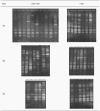Increased constituent ratios of Klebsiella sp., Acinetobacter sp., and Streptococcus sp. and a decrease in microflora diversity may be indicators of ventilator-associated pneumonia: a prospective study in the respiratory tracts of neonates
- PMID: 24586277
- PMCID: PMC3930531
- DOI: 10.1371/journal.pone.0087504
Increased constituent ratios of Klebsiella sp., Acinetobacter sp., and Streptococcus sp. and a decrease in microflora diversity may be indicators of ventilator-associated pneumonia: a prospective study in the respiratory tracts of neonates
Erratum in
- PLoS One. 2014;9(8):e105928
Abstract
Ventilator-associated pneumonia (VAP) is a common complication and cause of death in neonates on mechanical ventilation. However, it is difficult to define the causes of VAP. To understand the causes of VAP, we undertook a prospective study based on the diversity of the microflora in VAP. The experimental group consisted of newborns who suffered from respiratory distress syndrome (RDS) and VAP, while the control group suffered from RDS without VAP. Sputa were collected within 1, 3, and 5 days of ventilation and were divided into six groups. DNA was extracted from the samples, and the 16S rDNA was PCR amplified, separated using denaturing gradient gel electrophoresis (DGGE), cloned and sequenced. The resulting sequences were compared using BLAST. The DGGE pictures were measured, and the richness, Shannon-Wiener index, and cluster maps were analyzed. No differences were found regarding the constituent ratio of any genus between the Non-VAP and VAP group within 1 day after intubation. After 1 to 3 days, the constituent ratios of Klebsiella sp., Acinetobacter sp., and Streptococcus sp. in the VAP group were higher than those in the Non-VAP group, and the ratios of Serratia sp. and Achromobacter sp. were lower. After 3 to 5 days, the ratios of Klebsiella sp., Acinetobacter sp., Serratia sp., and Achromobacter sp. were lower than those in the Non-VAP group. The richness and Shannon-Wiener index of the Non-VAP group were higher than those of the VAP group from 1 to 3 days after intubation, while no differences were found within 1 day and from 3 to 5 days. We conclude that during the first three days of intubation, the microflora diversity in the lower respiratory tract was reduced due to VAP, and the greater constituent ratios of Klebsiella sp., Acinetobacter sp., and Streptococcus sp. in the sputum may be indicators of VAP.
Conflict of interest statement
Figures






References
-
- Michael Balter (2012) Taking stock of the human microbiome and disease. Science 336: 1246–1247. - PubMed
-
- Yalaz M, Altun-Köroğlu O, Ulusoy B, Yildiz B, Akisu M, et al. (2012) Evaluation of device-associated infections in a neonatal intensive care unit. Turk J Pediatr 54: 128–135. - PubMed
-
- Grgurich PE, Hudcova J, Lei Y, Sarwar A, Craven DE (2013) Diagnosis of ventilator-associated pneumonia: controversies and working toward a gold standard. Curr Opin Infect Dis 26: 140–150. - PubMed
-
- Celik IH, Oguz SS, Demirel G, Erdeve O, Dilmen U (2012) Outcome of ventilator- associated pneumonia due to multidrug-resistant Acinetobacter baumannii and Pseudomonas aeruginosa treated with aerosolized colistin in neonates: a retrospective chart review. Eur J Pediatr 171: 311–316. - PubMed
Publication types
MeSH terms
Substances
LinkOut - more resources
Full Text Sources
Other Literature Sources
Research Materials

